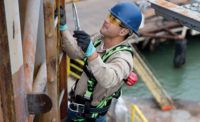Military tactics for hearing conservation
Best practices you can apply to your program

Concern of such medical injuries and lifelong illnesses reached members of Congress, who charged the Government Accountability Office (GAO) to study and report upon the root cause and tactics employed by military Hearing Conservation Programs to prevent further hearing loss. The resulting report was “Hearing Loss Prevention: Improvements to DoD Hearing Conservation Programs Could Lead to Better Outcomes.”
In the hearing conservation community, we’ve always looked to the DoD for best practices, and the GAO highlighted enhanced tactics that can be employed in occupational Hearing Conservation Programs.
Best practices
Link hearing safety to the job: The U.S. Army’s Hearing Program was highlighted for its policy linking hearing health to deployment status which improved compliance with hearing tests, and giving individual soldiers and unit commanders clear accountability for taking steps to protect soldiers’ hearing. The Army’s Hearing Program puts the focus on mission accomplishment in a safe and productive manner rather than on compliance only. The Army learned from its own studies that productivity is improved with appropriate hearing protection. Consider the auditory needs of various tasks and ensure that workers value and use hearing to safely get the job done.
Workplace Application: In every workplace, this translates into empowering employees to be involved in identifying and correcting safety issues, finding the “right” hearing protection that allows and maybe even enhances communication and situational awareness, and ensuring workers can hear what they need to hear to get the job done safely.
Document improvements: The U.S. Air Force’s Occupational and Environment Health Working Group was cited as an exemplary way to coordinate across departments and review data on a wide range of health hazards and indicators.
Workplace Application: Every workplace should have regular discussions regarding hearing conservation and other safety metrics. If significant hearing loss or trends toward hearing loss are identified on audiometric testing, the working group should conduct a site visit to determine its cause and make recommendations to mitigate the noise.
“Buy Quiet”: The GAO report noted some successes in the DoD’s efforts to “Buy Quiet” in its procurement of weapons systems to minimize hazardous noise exposure. Under a “Buy Quiet” program, RFPs specify maximum decibel levels in equipment, along with other mechanical and technical requirements. The report did note that noise is not a primary consideration for most of the military’s procurement/purchasing decisions. Additional examples of best practices in a “Buy Quiet” program have been also published by NASA (link: http://adl.grc.nasa.gov/buy-quiet-purchasing).
Workplace Application: Work with operations, facility management and procurement departments to specify quieter equipment when soliciting proposals.
Recommendations
Recommendations from the GAO report can be applied to every occupational Hearing Conservation Program.
address issues with the type, timing and tracking of training and education
develop an appropriate set of performance indicators
improve processes to collect and use performance data
examine services’ reviews to identify opportunities for program improvement
Training: The number-one recommendation from the GAO report is about training; specifically, instruction in the proper use of hearing protection before exposure to hazardous noise. The report also cited education and training during audiometric exams as “lost opportunities for hearing loss prevention.”
Metrics: When developing metrics for your occupational Hearing Conservation Program, program managers and safety committees should consider:
Are workers suffering occupational hearing loss? Audiometric testing is still a good way to measure if workers are losing hearing.
What levels of hazardous noise are workers exposed to? Measuring exposure levels after any change in the environment, equipment, process, worker activity, extended work shift etc. can document the effect of that change.
How much protection do workers get from their earplugs? Measuring the amount of real world protection (attenuation) that workers get from their own earplugs is a relatively new metric and certainly a leading indicator of a hearing loss prevention program.
Are workers using the appropriate hearing protection? Once the appropriate earplugs are determined for an employee, a sticker on a hard hat, a badge or some other marker may be used to identify which earplug is the right one (or ones) for that worker.
Are workers using hearing protection when it is needed? The best way to document if workers are really protected by their hearing protection is in-ear monitoring.
Are workers using PPE effectively? Workers may even be motivated and trained to use hearing protection off the job as well.
How consistent is the protection provided by an earplug? Repeat fit-testing by an individual can document the variability of fit that workers get with a given earplug. Or in-ear monitoring can be used for some period of time to check or re-check consistency of use.
What earplugs are needed to provide “appropriate selection” of hearing protection? Knowing what level of protection earplugs provide for your workers helps you to ensure that you keep the proper selection in stock and available for workers to use.
Are workers trained in hearing loss prevention? A more prevention-focused metric may be to use in-ear monitoring to train the worker when they need hearing protection and whether that protection is working. Measuring the desired behavior is certainly a better metric than just checking attendance at training sessions.
Summary
In applying the GAO’s findings to your own occupational Hearing Conservation Program, continually seek to decrease the noise level your employees are exposed to, train over-exposed employees to protect themselves appropriately, develop and document metrics to show performance, and continually look for ways to improve the HCP. Approach the problem of hearing loss more strategically by capitalizing on areas of success and targeting areas of weakness.
Looking for a reprint of this article?
From high-res PDFs to custom plaques, order your copy today!



